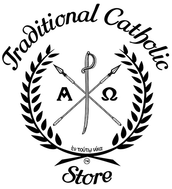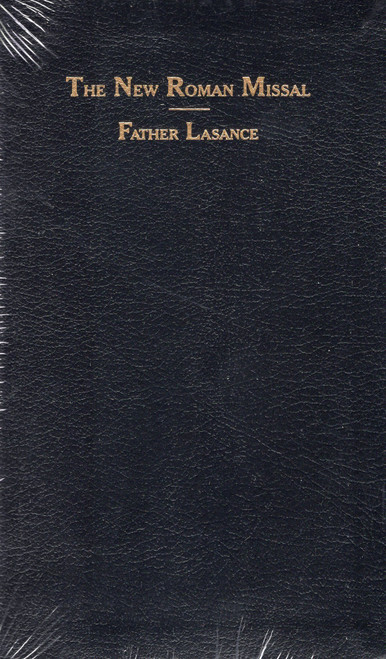The only complete Roman Missal according to the typical edition of 1962 approved by the Church!
The “1962 Daily Missal” contains the English translations and the Latin originals of the rites and texts for Holy Mass and many other liturgical ceremonies that were attended by the vast majority of Roman Catholics in the centuries before the liturgical reforms of Vatican Council II took effect. The liturgy of the 1962 Daily Missal is better known as the “Tridentine Mass”, “Traditional Latin Rite” or “Traditional Roman Rite” and since 2007 as the “Extraordinary Form of the Roman Rite”.
With its splendid texts and ceremonies that orient both priest and people entirely to the worship of God, this form of the sacred liturgy has fostered a living faith that has produced numerous saints and inspired countless artists, writers and thinkers to create much of what we now know as Western culture. Thanks to Pope Benedict XVI’s Apostolic Letter “Summorum Pontificum” in 2007, this form of the liturgy is now being celebrated more regularly and freely.
Features of the Baronius Press edition of the 1962 Daily Missal:
- 2,248 pages printed in red/black.
- Size approximately 4.25" x 6.85"
- Full Latin and English text of the Motu Proprio Summorum Pontificum issued by Pope Benedict XVI on 7th July 2007.
- 115 engravings throughout carefully scanned, corrected where necessary and digitally remastered.
- Foreword and Imprimatur from the Most Reverend Fabian W. Bruskewitz, STD, Bishop of Lincoln.
- All the Masses of the Liturgical Year, in Latin with English translation (Biblical texts are from the Douay-Rheims), according to the Roman Calendar of 1962 - Temporal and Sanctoral Cycles and accompanying rites (Blessing of Ashes, Blessing of Palms, Chrism Mass, and the Blessing of Holy Oils, etc)
- Ordinary of the Mass, in Latin with English translation
- Liturgical Calendar
- Table of Moveable Feasts up to AD 2066
- Complete Holy Week Liturgy of 1962 (including the Office of Tenebrae)
- Common Masses of the Saints and the Blessed Virgin
- Supplement of special Masses for the Dioceses of the USA
- Supplement of special Masses for the Dioceses of England and Wales
- Supplement of special Masses for the Dioceses of Scotland
- Supplement of special Masses for the Dioceses of Australia and New Zealand
- Feasts celebrated in particular places and in certain religious congregations
- Votive Masses for the days of the week
- Sixteen Votive Masses for various occasions
- Masses for the Dead (including infants), Complete Burial Service, Prayers for the Dead
- Marriage Service and Nuptial Mass
- The Churching of Women
- Kyriale, in traditional Gregorian chant notation, including:
- Tones for the most common Ordinaries: I (Lux et Origo), IV (Cunctipotens Genitor Deus), VIII (De Angelis), IX (Cum Jubilo), XI (Orbis Factor), XXVII (Sundays of Advent & Lent), XVIII (Deus Genitor Alme)
- Tones for the Asperges and the Vidi Aquam
- Tones for the Credo: I, II, III and IV
- Vespers for Sundays and Feasts
- Compline for Sundays
- Hymns and chants for Exposition and Benediction of the Blessed Sacrament
- Anthems to the Blessed Virgin Mary
- Litany of the Saints
- Various Devotions and Prayers including favourite Litanies, the Way of the Cross, prayers of the Rosary and others
- Morning and Evening Prayers
- Devotions for Confession
- Devotions for Holy Communion
- Te Deum Laudamus
- The Itinerary or Office before a Journey
- Various Blessings
- An explanation of "The Liturgy or Public Worship of the Catholic and Roman Church"
- An Abridgement of Christian Doctrine
A brief History of the Roman Missal
The Roman Missal of 1570 was promulgated by Pope St Pius V in execution of the decree of the Council of Trent. It was, Pope Paul VI reminds us, "one of the many admirable results that the Council achieved for the benefit of the entire Church of Christ."
Far from being a new rite of Mass, it was, as regards the Ordinary, Canon, Proper of the time and much else a replica of the Roman Missal of 1474, which in its turn repeated in all essentials the practice of the Roman Church of the epoch of Innocent III, which itself derived from the usage of Gregory the Great and his successors in the seventh century. In short, the Missal of 1570 was, in all essentials, the usage of the mainstream of medieval European liturgy.
This codification of the rite of Mass ensured that Latin-rite priests would be able to celebrate the Mass "according to the custom and rite of the holy Fathers", and protected the Mass against any temptation to change its prayers and ceremonies in the direction of Protestantism.
The prayers and ceremonies of this Missal are expressive of the traditional Catholic doctrines of the sacrifice of the Mass and the Real Presence of Our Lord in the Sacred Host, doctrines which the Council of Trent was at pains to articulate and emphasise, and which are under renewed attack in our day.
Legions of Catholic missionaries spread this Missal across the entire world, while innumerable holy men and women nurtured their spiritual lives on its ceremonies, its readings from Scripture and its prayer texts. In large part these prayer texts owe their arrangement to Pope St Gregory the Great – a holy legacy and tradition that forms our common Catholic patrimony, and a "witness to an unchanged Faith." A Faith, moreover, "which is an entire tradition originating in Christ."
|
It is my pleasure to introduce this revised and enlarged edition of The Daily Missal and Liturgical Manual. It will serve all Catholics who make use of the Roman Missal and associated rites promulgated or in use in 1962, in accordance with Pope Benedict XVI’s Motu Proprio Summorum Pontificum. This historic document has been included at the beginning of this volume. While this volume is essentially a reprint of the edition published in 1962, certain aspects of it have been updated to reflect the fact that the traditional rites continue to provide spiritual fruit in abundance to the Mystical Body of Christ in the 21st Century. The traditional Latin form of the Mass is not a museum piece, but rather a living liturgy that continues to provide spiritual succour and sustenance to the faithful in our own day. The supplementary feasts for Australia and New Zealand have been added to this edition, which combined with the supplements for the United Kingdom and United States that were included in previous editions, will make it a truly useful Missal for those who attend the traditional Latin form of the Mass throughout the English speaking world. It is my hope that this finely produced hand missal will continue to serve Catholics attending the Extraordinary form of the Roman Rite, helping them to appreciate its particular beauty and reverence. The Most Reverend Fabian W. Bruskewitz, STD
|









